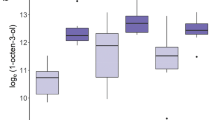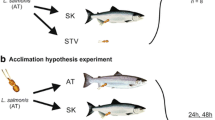Abstract
Adult male salmon lice, Lepeophtheirus salmonis, displayed kinetic and rheotactic behavioral responses to seawater conditioned with the Atlantic salmon, Salmo salar. The kinetic response was initiated by a range of skin, mucus, and flesh preparations from salmon and from a nonsalmonid, the turbot Scophthalmus maximus. Kinesis was quantified by digitally recording the movement of individual lice and by measuring both speed and distance traveled. A directional response, measured in Y-tube assays, was seen in the presence of salmon-conditioned water, but not of turbot-conditioned water. Thus, there is strong evidence that chemical signals are used by salmon lice to mediate host-finding behavior. It is hypothesized that, although salmon lice are excited by the presence of fish-derived semiochemicals, there is a salmonid-specific signal that mediates their positive rheotactic response to a host.
Similar content being viewed by others
REFERENCES
Blackwell, A., Mordue (Luntz), A. J., Hansson, B. S., Wadhams, L. J., and Pickett, J. A. 1993. A behavioural and electrophysiological study of oviposition cues for Culex quinquefasciatus. Physiol. Entomol. 18:343–348.
Blackwell, A., Dyer, C., Mordue (Luntz), A. J., Wadhams, L. J., and Mordue, W. 1996. The role of 1-octen-3-ol as a host-odour attractant for the biting midge, Culicoides impunctatus Goetghebuer, and interactions of 1-octen-3-ol with a volatile pheromone produced by parous female midges. Physiol. Entomol. 21:15–19.
Boudreau, B., Bourget, E., and Simard, Y. 1993. Behavioral responses of competent lobster postlarvae to odor plumes. Mar. Biol. 117:63–69.
Boxshall, G. A. 1976. The host specificity of Lepeophtheirus pectoralis (Muller 1776) (Copepoda: Caligidae). J. Fish Biol. 8:255–264.
Carte, B., and Faulkner, D. J. 1986. Role of secondary metabolites in feeding associations between a predatory nudibranch, 2 grazing nudibranchs, and a bryozoan. J. Chem. Ecol. 12:795–804.
Collier, L. M., and Pinn, E. H. 1998. An assessment of the acute impact of the sea lice treatment ivermectin on a benthic community. J. Exp. Mar. Biol. Ecol. 230:131–147.
Courtenay, S. C., Quinn, T. P., Dupuis, H. M. C., Groot, C., and Larkin, P. A. 1997. Factors affecting the recognition of population specific odours by juvenile coho salmon. J. Fish Biol. 50:1042–1060.
Denunez, M. O., and Haas, W. 1991. Penetration stimuli of fish skin for Acanthostomum brauni cercariae. Parasitology 102:101–104.
Douglas, J. D. M. 1995. Salmon farming-occupational-health in a new rural industry. Occup. Med. 45:89–92.
Fasten, N. 1913. The behaviour of a parasitic copepod Lernaeopoda edwardsii Olsson. J. Anim. Behav. 3:36–60.
Giattina, J. D., and Garton, R. R. 1983. A review of the preference-avoidance responses of fishes to aquatic contaminants. Residue Rev. 87:43–90.
Griffiths, A. M., and Frost, B. W. 1976. Chemical communications in the marine planktonic copepods Calanus pacificus and Pseudocalanus sp. Crustaceana 30:1–9.
Hay, M. E., Stachowicz, J. J., Cruz-Rivera, E., Bullard, S., Deal, M. S., and Lindquist, N. 1998. Bioassays with marine and freshwater macroorganisms, pp. 39–141, in K. F. Haynes and J. G. Millar (eds.). Methods in Chemical Ecology, Vol. 2. Bioassay Methods. Chapman and Hall, New York.
Hirano, T., Zhang, C. H., Morishita, A., Suzuki, T., and Shirai, T. 1992. Studies on the odour of fishes. 1. Identification of volatile compounds in Ayu fish and its feeds. Nippon Suisan Gakkaishi (Bull. Jpn. Soc. Sci. Fish.) 58:547–557.
Howse, P., Stevens, I., and Jones, O. 1996. Insect Pheromones and Their Use in Pest Management. Chapman and Hall, London, 256 pp.
Hull, M. Q. 1997. The role of semiochemicals in the behaviour and biology of Lepeophtheirus salmonis (Krø yer 1837): Potential for control? PhD thesis. University of Aberdeen, Aberdeen, UK.
Hull, M. Q., Mordue (Luntz), A. J., Pike, A. W., and Rae, G. 1998. Patterns of pair formation and mating in an ectoparasitic caligid copepod Lepeophtheirus salmonis (Kroyer 1837); implications for its sensory and mating biology. Phil. Trans. R. Soc. London Ser. B 353:753–764.
Jakobsen, P. J., and Wedekind, C. 1998. Copepod reaction to odor stimuli influenced by cestode infection. Behav. Ecol. 9:414–418.
Johnson, S. C., and Albright, L. J. 1992. Comparative susceptibility and histopathology of the response of naive atlantic, chinook and coho salmon to experimental infection with Lepeophtheirus salmonis (Copepoda, Caligidae). Dis. Aquat. Org. 14:179–193.
Jones, M. W., Somerville, C., and Wootten, R. 1992. Reduced sensitivity of the salmon louse, Lepeophtheirus salmonis, to the organophosphate dichlorvos. J. Fish Dis. 15:197–202.
Kabata, Z. 1979. Parasitic Copepoda of British Fishes. Ray Society, London, 468 pp.
Kabata, Z. 1981. Copepoda (Crustacea) parasitic on fishes: Problems and perspectives. Adv. Parasitol. 19:2–63.
Katona, S. 1973. Evidence for sex pheromones in planktonic copepods. Limnol. Oceanogr. 18:574–583.
Lebedeva, N. E., and Golovkina, T. V. 1994. Fishes natural chemical signals-its meaning and some properties. Biofizika 39:534–537.
McKenzie, J. A. 1996. Ecological and Evolutionary Aspects of Insecticide Resistance. Academic Press, London, pp. 164–166.
Murlis, J., Elkinton, J. S., and CardÉ, R. T. 1992. Odor plumes and how insects use them. Annu. Rev. Entomol. 37:505–532.
Nese, L., and Enger, O. 1993. Isolation of Aeromonas salmonicida from salmon lice Lepeophtheirus salmonis and marine plankton. Dis. Aquat. Org. 16:79–81.
Nylund, A., Wallace, C., and Hovland, T. 1993. The possible role of Lepeophtheirus salmonis (Krø yer) in the transmission of infectious salmon anaemia, pp. 367–373, in G. A. Boxshall and D. Defaye (eds.). Pathogens of Wild and Farmed Fish: Sea Lice. Ellis Horwood, Chichester, UK.
Pike, A. W., and Wadsworth, S. L. 1999. Sealice on salmonids: Their biology and control. Adv. Parasitol. 44:233–337.
Purcell, J. E., and Anderson, P. A. V. 1995. Electrical responses to water soluble components of fish mucus recorded from the cnidocytes of a fish predator, Physalia physalis. Mar. Freshwater Behav. Physiol. 26:149–162.
Ritchie, G. 1997. The host transfer ability of Lepeophtheirus salmonis (Copepoda: Caligidae) from farmed Atlantic salmon, Salmo salar L. J. Fish Dis. 20:153–157.
Ross, A. 1989. Nuvan use in salmon farming the antithesis of the precautionary principle. Mar. Pollut. Bull. 20:372–374.
Roth, M., Richards, R. H., Dobson, D. P., and Rae, G. H. 1996. Field trials on the efficacy of the organophosphorus compound azamethiophos for the control of sea lice (Copepoda: Caligidae) infestations of farmed Atlantic salmon (Salmo salar). Aquaculture 140:217–239.
Tsuda, A., and Miller, C. B. 1998. Mate finding behaviour in Calanus marshallae Frost. Phil. Trans. R. Soc. London Ser. B. 353:713–720.
Vale, G. A., Lovemore, D. F., Flint, S., and Cockbill, G. F. 1988. Odor-baited targets to control tsetse flies, Glossina spp. (Diptera, Glossinidae), in Zimbabwe. Bull. Entomol. Res. 78:31–49.
Zhang, C. H., Hirano, T., Suzuki, T., and Shirai, T. 1992a. Studies on the odour of fishes. 2. Enzymatically generated specific volatile compounds in Ayu tissues. Nippon Suisan Gakkaish i (Bull. Jpn. Soc. Sci. Fish.) 58:559–565.
Zhang, C. H., Hirano, T., Suzuki, T., Shirai, T., and Morishita, A. 1992b. Studies on the odour of fishes. 3. Volatile compounds and their generation in smelt. Nippon Suisan Gakkaishi (Bull. Jpn. Soc. Sci. Fish.) 58:773–779.
Author information
Authors and Affiliations
Rights and permissions
About this article
Cite this article
Devine, G.J., Ingvarsdóttir, A., Mordue, W. et al. Salmon Lice, Lepeophtheirus salmonis, Exhibit Specific Chemotactic Responses to Semiochemicals Originating from the Salmonid, Salmo salar. J Chem Ecol 26, 1833–1847 (2000). https://doi.org/10.1023/A:1005592606682
Issue Date:
DOI: https://doi.org/10.1023/A:1005592606682




